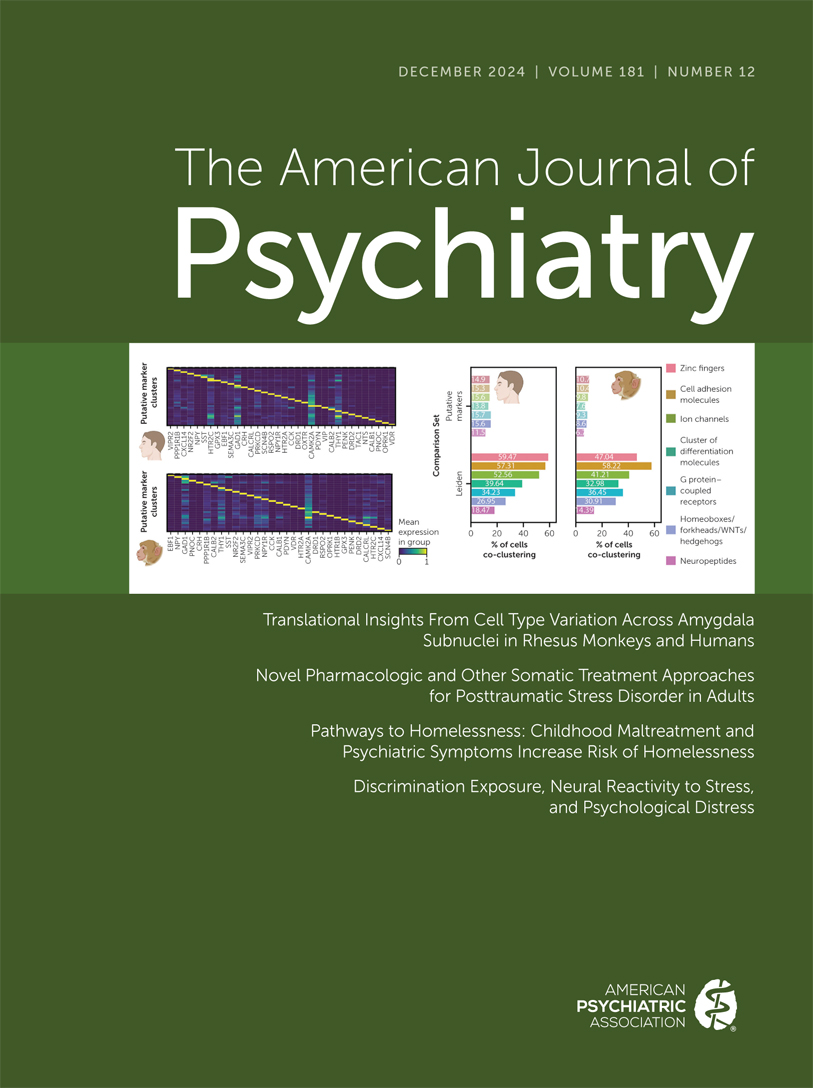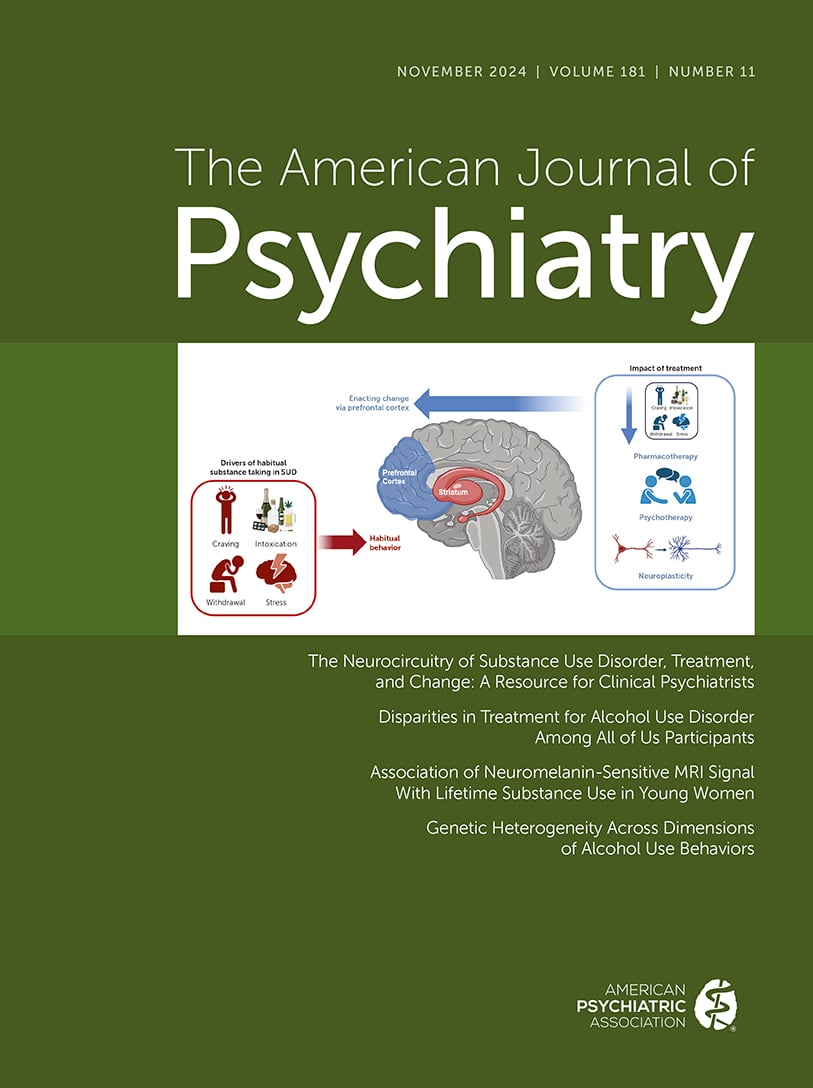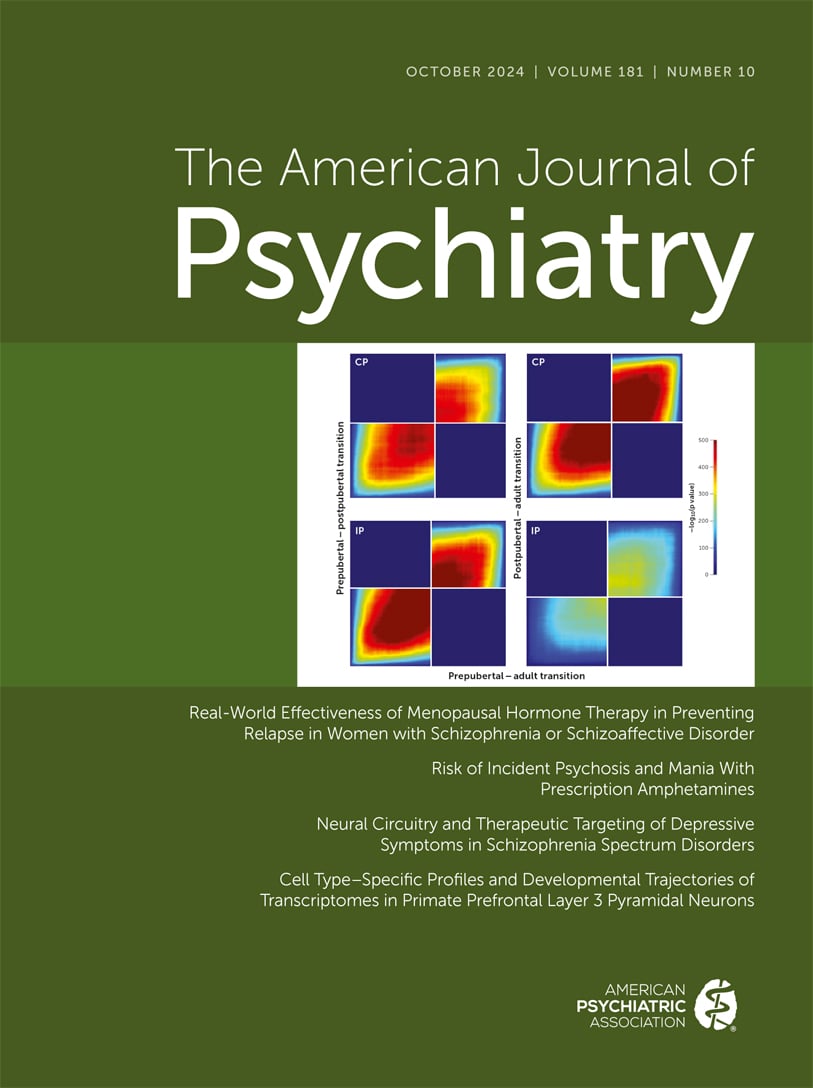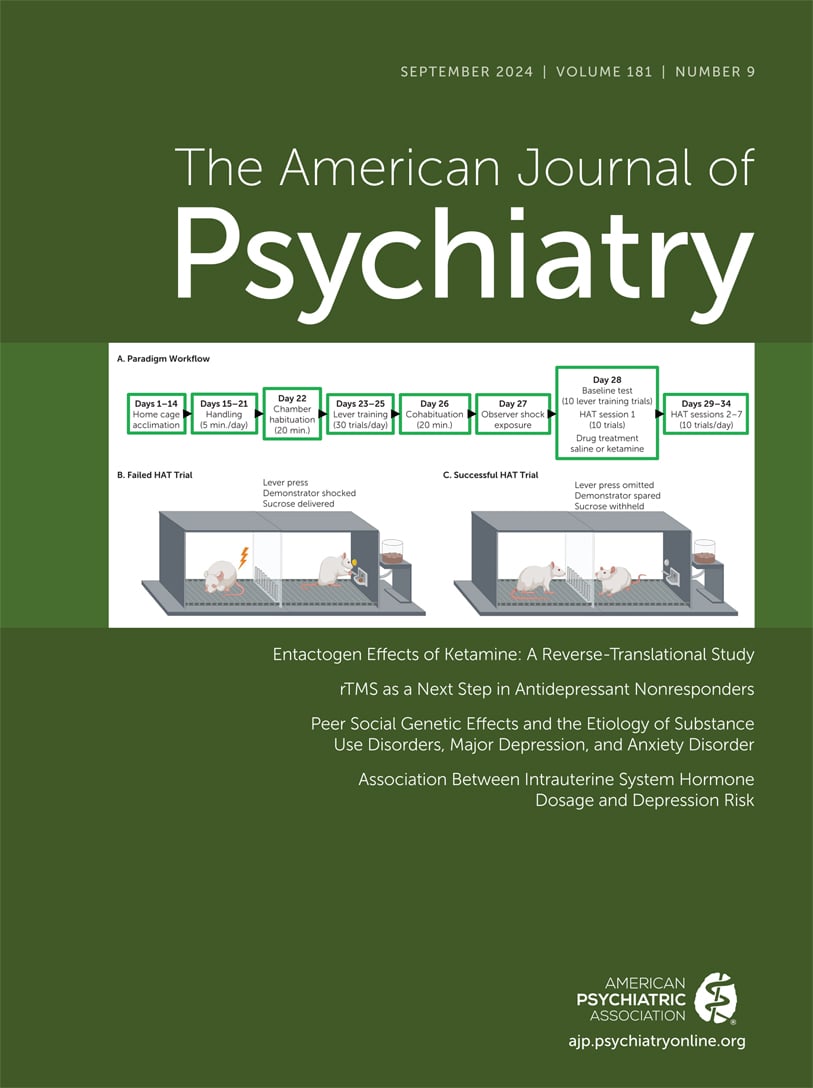American Journal of Psychiatry
- Volume 157
- Number 4
- April 2000
Editorial
Images in Neuroscience
Special Article
Publication date: 01 April 2000
Pages493–505OBJECTIVE: In a 1989 article, the authors provided a hypothesis for the neuroanatomical basis of panic disorder that attempted to explain why both medication and cognitive behavioral psychotherapy are effective treatments. Here they revise that hypothesis ...
https://doi.org/10.1176/appi.ajp.157.4.493Regular Article
Publication date: 01 April 2000
Pages506–513OBJECTIVE: While researchers have increasing insight into the role of genetic and environmental factors in the etiology of psychiatric and substance use disorders, they know much less about how such factors influence the dimensions of healthy ...
https://doi.org/10.1176/appi.ajp.157.4.506Publication date: 01 April 2000
Pages514–520OBJECTIVE: Since all antipsychotics block dopamine D2 receptors, the authors investigated how well D2 receptor occupancy in vivo predicts clinical response, extrapyramidal side effects, and hyperprolactinemia. METHOD: In a double-blind study, 22 patients ...
https://doi.org/10.1176/appi.ajp.157.4.514Publication date: 01 April 2000
Pages521–527OBJECTIVE: This article evaluates barriers to treatment reported by adults with social anxiety who participated in the 1996 National Anxiety Disorders Screening Day. METHOD: The background characteristics of screening day participants with symptoms of ...
https://doi.org/10.1176/appi.ajp.157.4.521Publication date: 01 April 2000
Pages528–541OBJECTIVE: Identity disturbance is one of the nine criteria for borderline personality disorder in DSM-IV, yet the precise nature of this disturbance has received little empirical attention. This study examines 1) the extent to which identity disturbance ...
https://doi.org/10.1176/appi.ajp.157.4.528Publication date: 01 April 2000
Pages542–548OBJECTIVE: Whether chronicity of illness produces progressive neural abnormality is an important question in current schizophrenia research. Positron emission tomography (PET) offers an opportunity to visualize and measure blood flow in vivo to address ...
https://doi.org/10.1176/appi.ajp.157.4.542Publication date: 01 April 2000
Pages549–559OBJECTIVE: Neuropsychological impairments are well documented in schizophrenia and are important targets of treatment. Information about the severity and pattern of deficits after treatment for the first psychotic episode and about relationships between ...
https://doi.org/10.1176/appi.ajp.157.4.549Publication date: 01 April 2000
Pages560–565OBJECTIVE: More than 20 studies of schizophrenia have found a three-factor model of symptom complexes or syndromes consisting of hallucinations/delusions, disorganization of thought and behavior, and negative symptoms. Several lines of evidence suggest ...
https://doi.org/10.1176/appi.ajp.157.4.560Publication date: 01 April 2000
Pages566–572OBJECTIVE: Previous work has suggested that delusions are associated with a higher risk of violence, particularly delusions in which patients believe that people are seeking to harm them or that outside forces are controlling their minds (denoted as “...
https://doi.org/10.1176/appi.ajp.157.4.566Publication date: 01 April 2000
Pages573–580OBJECTIVE: Research studies on the validity of current diagnostic and subthreshold categories of depression that use a population-based follow-up design are rare. The authors examined the validity and utility of four current depression categories by ...
https://doi.org/10.1176/appi.ajp.157.4.573Publication date: 01 April 2000
Pages581–587OBJECTIVE: Diagnosis-specific, proven efficacious treatments are a major recent advance in psychiatry. Appropriate use of such treatments presupposes patients who meet the diagnostic criteria and clinicians who have accurately diagnosed the target ...
https://doi.org/10.1176/appi.ajp.157.4.581Publication date: 01 April 2000
Pages588–594OBJECTIVE: Researchers have not systematically examined how exclusion criteria used in selection of research subjects affect the generalizability of treatment outcome research. This study evaluated the use of exclusion criteria in alcohol treatment ...
https://doi.org/10.1176/appi.ajp.157.4.588Publication date: 01 April 2000
Pages595–600OBJECTIVE: Mental health evaluation of competence to consent has been proposed as an important safeguard for patients requesting assisted suicide, yet mental health professionals have not developed guidelines or standards to aid in such evaluations. The ...
https://doi.org/10.1176/appi.ajp.157.4.595Publication date: 01 April 2000
Pages601–608OBJECTIVE: Suicidal behavior is highly prevalent in borderline personality disorder and major depressive episode, although the characteristics of suicide attempts in the two disorders are believed to differ. Comorbidity of borderline personality disorder ...
https://doi.org/10.1176/appi.ajp.157.4.601Publication date: 01 April 2000
Pages609–614OBJECTIVE: The purpose of this study was to determine whether aggression and serotonergic dysfunction are related in the absence of a history of suicidal behavior. Although serotonergic dysfunction has been implicated in aggressive and impulsive behavior, ...
https://doi.org/10.1176/appi.ajp.157.4.609Publication date: 01 April 2000
Pages615–619OBJECTIVE: The purpose of this study was to examine posttraumatic stress disorder (PTSD) among Hispanics who served in the Vietnam War. METHOD: The authors conducted secondary data analyses of the National Vietnam Veterans Readjustment Study, a national ...
https://doi.org/10.1176/appi.ajp.157.4.615Clinical Case Conference
Images in Psychiatry
Brief Report
Publication date: 01 April 2000
Pages626–628OBJECTIVE: To assess the ability of acute stress disorder to predict posttraumatic stress disorder (PTSD), the relationship between acute stress disorder and PTSD over the 2 years following mild traumatic brain injury was determined. METHOD: Survivors of ...
https://doi.org/10.1176/appi.ajp.157.4.626Publication date: 01 April 2000
Pages629–631OBJECTIVE: This study indexed the profile of posttraumatic stress disorder (PTSD) after severe traumatic injury to the brain. METHOD: Patients who sustained a severe traumatic brain injury (N=96) were assessed for PTSD 6 months after the injury with the ...
https://doi.org/10.1176/appi.ajp.157.4.629Publication date: 01 April 2000
Pages632–634OBJECTIVE: The authors’ goal was to study presynaptic dopamine activity in smoking and nonsmoking human subjects in vivo. METHOD: [18F]Fluorodopa ([18F]DOPA) uptake Ki values in the basal ganglia of nine smoking and 10 nonsmoking healthy men were measured ...
https://doi.org/10.1176/appi.ajp.157.4.632Publication date: 01 April 2000
Pages635–637OBJECTIVE: The study examined the influence of losses in dopaminergic function on age-related cognitive deficits. METHOD: Eleven healthy subjects (21–68 years of age) completed a set of cognitive tasks used to assess perceptual speed and episodic memory. ...
https://doi.org/10.1176/ajp.157.4.635Publication date: 01 April 2000
Pages638–640OBJECTIVE: The study assessed the effects on global cognitive function and mood of a reduction of brain serotonin by means of acute tryptophan depletion in 16 patients with dementia of the Alzheimer type and in 16 cognitively intact comparison subjects. ...
https://doi.org/10.1176/appi.ajp.157.4.638Publication date: 01 April 2000
Pages641–643OBJECTIVE: Proton magnetic resonance spectroscopy (1H-MRS) was used to study medial prefrontal metabolic impairments in schizophrenic patients with the deficit syndrome. METHOD: The subjects were 22 schizophrenic patients categorized as deficit (N=5) or ...
https://doi.org/10.1176/appi.ajp.157.4.641Publication date: 01 April 2000
Pages644–647OBJECTIVE: The authors measured N-acetylaspartate (a putative neuronal marker) in the right and left thalamus of 17 male patients with schizophrenia using in vivo proton magnetic resonance spectroscopic imaging (1H MRSI). METHOD: 1H MRSI was performed on ...
https://doi.org/10.1176/appi.ajp.157.4.644Publication date: 01 April 2000
Pages648–650OBJECTIVE: The study was conducted to estimate the association between serum total cholesterol concentration and mortality from suicide. METHOD: The baseline serum total cholesterol concentration of 37,635 adults was determined in five independent ...
https://doi.org/10.1176/appi.ajp.157.4.648Book Forum: PSYCHOANALYSIS
Book Forum: SUBSTANCE ABUSE
Book Forum: CHILD ABUSE AND PTSD
Book Forum: MOOD DISORDERS
Letter to the Editor
Past Issues
View Issues Archive
Vol. 181 | No. 12

Vol. 181 | No. 11

Vol. 181 | No. 10
